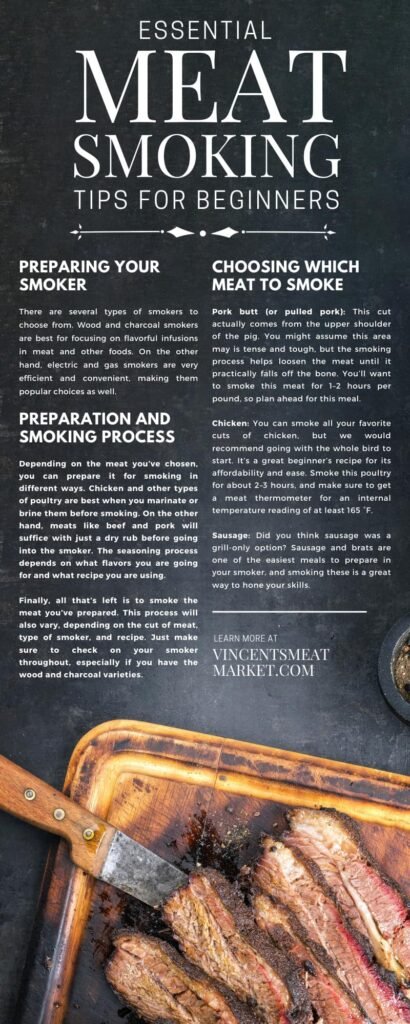Have you ever stood in front of a smoking grill, tongs in hand, questioning whether you’re about to over-smoke your brisket to the point of no return? Rest assured, we’re in the same boat. Smoking meat is a time-honored tradition that can transform a humble cut into a mouthwatering masterpiece.
We know the key is not just in the smoke but in getting the timing just right. It’s a common dilemma we face: “How long should you smoke different types of meat?” Today, we’re moseying through this smoky terrain to find answers and share insights that will have us all serving up delicious, tender meat, much to the delight of our friends and family.

This image is property of images.pexels.com.
Understanding the Basics of Smoking Meat
Let’s start by breaking down some fundamental concepts. Smoking meat can be a bit like an art form. It’s about nurturing that cut of meat until it reaches perfection—a process requiring time, patience, and a bit of smoke. We can all agree that great smoked meat is neither rushed nor undercooked. Understanding the nuances of smoking different types is essential for anyone aiming to master the art.
The Science Behind Smoking Meat
When we’re talking about smoking meat, what exactly are we doing? Well, it’s a process that uses low temperatures and long times to cook food, and it involves infusing that food with the flavors of wood smoke. The smoke from woods like hickory, oak, or apple not only cooks the meat but also imparts those aromatic, complex flavors we crave.
The magic happens because the smoke contains chemical compounds like syringol and guaiacol, which penetrate the meat, offering layers of flavor. Time and temperature become our most trusted allies here, as they allow these compounds to do their work effectively.
Essential Tools for Smoking
Before we dive into the specifics of smoking times, let’s ensure our toolkit is in check. We don’t need a ton of fancy gadgets to get started, but a few essentials are non-negotiable if we want to do this right.
Smokers and Grills
There’s a plethora of smokers out there, from electric to charcoal or pellet varieties. Our choice will often boil down to personal preference and, sometimes, budget. However, what they all have in common is creating that perfect environment for smoking—low and slow.
Thermometers
Investing in a good digital meat thermometer is crucial. Visual checks can often let us down; only a thermometer can tell us precisely when our meat reaches the perfect temperature and ensure food safety.
Wood Chips and Chunks
The type of wood we use can significantly influence the flavor profile. Hickory offers a strong, hearty flavor, perfect for red meats, while fruitwoods like apple or cherry provide a milder, sweeter smoke that works wonders on poultry or pork.

This image is property of images.pexels.com.
Smoking Beef
Beef and smoke are a match made in barbecue heaven. Let’s unravel the mysteries of smoking different beef cuts, focusing on the rich, smoky flavors they can offer.
Brisket
No discussion on smoking beef is complete without mentioning brisket, the Holy Grail for many of us. This large cut requires a long smoking time to break down the connective tissues and fat, ensuring it remains moist.
How Long and at What Temperature Should We Smoke Brisket?
A general rule is to smoke brisket at 225-250°F (about 107-121°C). For the time, we give ourselves approximately 1 to 1.5 hours per pound. So, a 10-pound brisket might take anything from 10 to 15 hours. Let’s remember, patience is a virtue, especially when it comes to brisket.
Ribs
Beef ribs are another decadent treat that benefits from a smoky embrace. While their smoking time is not as extensive as brisket, they still require care and time.
Ideal Smoking Time for Beef Ribs
Beef ribs typically smoke for 5-6 hours at a temperature of 225°F (107°C). Our aim here is to achieve that fall-off-the-bone tenderness, the kind that makes us want to lick our fingers and reach for more.
Smoking Pork
Pork is wonderfully forgiving and absorbs smoke like a dream. Whether it’s pork shoulder or ribs, the flavor profile is unmatched.
Pork Shoulder or Butt
Known for becoming pull-apart tender, pork shoulder or butt is our go-to for classic pulled pork.
Smoking Time and Temperature for Pork Shoulder
We usually smoke pork shoulder at 225°F (107°C) for about 1.5 to 2 hours per pound. Much like brisket, it requires a longer time to break down the collagen. We encourage ourselves to wrap the pork in foil or butcher paper once the meat hits about 160°F for a juicier result.
Pork Ribs
Let’s not forget the crowd-pleasing pork ribs. The perfect ribs are tender but maintain a bit of bite to them.
Smoking Duration for Pork Ribs
For pork ribs, we normally smoke them for 5-6 hours at 225°F (107°C). It’s helpful to use the 3-2-1 method: 3 hours unwrapped, 2 hours wrapped in foil with a bit of moisture, and 1 hour unwrapped to firm up the bark.

This image is property of images.pexels.com.
Smoking Poultry
Poultry is a versatile meat that benefits from a shorter smoke time than its beefy or porky counterparts, but the results can be equally delightful.
Chicken
Whether we’re smoking a whole chicken or pieces, poultry is great at absorbing smoke flavors, particularly with lighter woods like apple or cherry.
Time Guidelines for Smoking Chicken
Whole chickens typically take about 2.5 to 3 hours at 225°F (107°C). Chicken pieces, on the other hand, may only need 1.5 to 2 hours. It’s crucial to ensure the internal temperature reaches at least 165°F (74°C) for safety.
Turkey
For holidays, or whenever we feel like having a feast, smoked turkey can be a show-stopper.
Smoking Length for Turkey
A whole turkey needs about 30-40 minutes per pound at the same temperature of 225°F. So, a 12-pound bird could spend up to 8 hours in the smoker. Remember, as with chicken, getting that internal temp to 165°F is the goal.
Smoking Fish
While not as common as meat, smoked fish is a delicacy offering its own unique flavors.
Salmon
Our favorite for smoking is often salmon, thanks to its rich, fatty nature.
Ideal Smoking Time for Salmon
Salmon can be hot smoked or cold smoked, but for hot smoking, we’re looking at around 30 minutes to an hour at 225°F, depending on the thickness of the filets. The aim is for an internal temp of about 145°F.
Understanding the Timing and Temperature
To help simplify, here’s a handy table summarizing our smoking times and temperatures:
| Meat Type | Temperature (°F) | Time | Internal Temp to Reach (°F) |
|---|---|---|---|
| Brisket | 225-250 | 1-1.5 hours per pound | 195-205 |
| Beef Ribs | 225 | 5-6 hours | 190-203 |
| Pork Shoulder | 225 | 1.5-2 hours per pound | 195 |
| Pork Ribs | 225 | 5-6 hours (3 unwrapped, 2 wrapped, 1 unwrap) | 190-203 |
| Chicken | 225 | 2.5-3 hours (whole) or 1.5-2 hours (pieces) | 165 |
| Turkey | 225 | 30-40 minutes per pound | 165 |
| Salmon | 225 | 30 minutes to 1 hour | 145 |
Common Challenges and Solutions
Not everything always goes as planned. Sometimes, we run into hiccups that can threaten our all-but-guaranteed success. Let’s explore some common smoking conundrums and how we can tackle them.
The Meat Is Dry
Having dry meat is a common problem for many of us. If our meat is turning out dry, it could be that we’re smoking it at too high of a temperature or for too long. Using a water pan in the smoker to maintain moisture, and wrapping tougher cuts in foil can help combat this issue.
Too Much Smoke
It can happen if we’re too enthusiastic with the wood chips. A little smoke goes a long way, so we should ensure we’re not overloading our smoker, as it can overpower the meat and lead to a bitter taste.
Enhancing the Flavor: Rubs and Marinades
While smoking gives us that core flavor, rubs and marinades can enhance it further. Let’s talk about how we can use these flavor boosters.
Dry Rubs
A good dry rub can be the difference between a good barbecue and a great one. Whether it’s a simple mix of salt, pepper, and garlic, or a complex blend of spices, dry rubs add texture and flavor before the smoking even begins.
Marinades
Marinades work wonders for meat like chicken or fish. They penetrate the meat, adding moisture and depth to its natural flavors. Allowing our meat to sit in a marinade for a few hours or overnight can elevate our dish to the next level.
Innovations: Infusing Smoked Flavors
Beyond traditional smoking, there are new ways we can infuse smoke flavors into our dishes, broadening our culinary horizon.
Liquid Smoke
While purists may opt-out, liquid smoke offers us an option to add that smokey essence to our dishes without the actual smoking process. It works especially well in sauces and marinades.
Indoor Smokers
For those of us living in apartments or in smoke-free zones, indoor smokers now offer a compact solution. They allow us to experiment and enjoy smoked foods without needing a backyard.
Wrapping Up Our Smoking Adventure
After sifting through the whys and hows of smoking different types of meat, we remember that patience, practice, and attention to detail go hand-in-hand when pursuing that perfect smoky flavor. Every cut brings its own quirks, and it’s through trial and a few errors that we find our groove.
As we stand by our smoker next time, let’s vow to give each meat the attention it deserves—allowing time, patience, and flavor to mingle in delightful, savory harmony. Our efforts might just end in the inspired enjoyment of a meal deliciously combined with camaraderie and celebration.
So, fellow pitmasters, as we dig into our next smoky endeavor, let’s continue to ask the insightful questions, embracing the smoky trails set before us with open arms and hearty appetites. Happy smoking to us all—let’s make it count!





